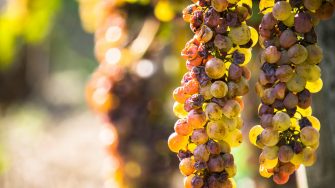Innovative rapid test to stop fungus ruining wine
A new in-field method to detect Botrytis cinerea in grapes in a manner of minutes.
A new in-field method to detect Botrytis cinerea in grapes in a manner of minutes.

No-one wants the quality and taste of their wine to be impacted by fungus, so a UNSW Canberra researcher, alongside researchers from Charles Sturt University (CSU), is working on testing the air around grapevines so grape growers can identify the risk much quicker than has been previously possible.
Dr Morphy Dumlao, alongside a team of researchers, has developed a new in-field approach for real-time detection of Botrytis cinerea, a common fungus found in grapes that can impact the quality of wine.
“Each fungus emits a trace level of volatile biosignatures, so when analysing the air around the grapes with the known botrytis biosignatures, we can see if it is present or not in a manner of minutes,” Dr Dumlao said.
This new testing method uses a pump to suck in air and pass it through special absorption materials that can capture the signs of Botrytis cinerea if present.
These samples are then subjected to Gas Chromatography Mass Spectrometry, a trusted method for confirmation of the biosignature, that was undertaken by PhD Student Jiang Liang from CSU. Further to this, Dr Dumloa directly connected the samples to a Mass Spectrometer (MS) which drastically reduces analysis time to just a few seconds.
“This breakthrough not only expedites the process but also allows for on-site verification, particularly when integrated with portable MS units,” Dr Dumlao said.
“Early detection means higher yields for the wine growers, better quality grapes, and a more cost-effective solution in both yield quantity and reduced cost of testing.”
While it is a common fungal infection in vineyards, Botrytis cinerea is caused by wet and humid weather conditions and is hard to detect as it is usually hidden within the interior of the grape bunch, by which time wine growers need to act fast to mitigate the spread of the disease through a more hands-on approach.
Although field tests are currently commercially available, they require another chemical test to confirm the results; something this new process doesn’t require. Current chemical tests need to be sent offsite to a laboratory which can then take days to come back with any results.
“Our aim is to develop a technique that cuts out the cost of chemical testing, the transport to a lab and the lengthy process time, so wine growers can know straight away with a simple yes or no in the field,” said Dr Dumlao.
This technique is still in a proof-of-concept phase, so further testing needs to be undertaken, but the results show a promising sign for not only detecting Botrytis cinerea but other fungal infections like Brettanomyces, a yeast that can cause significant spoilage in wines.
“We are hoping to roll out this approach, but we need further validation. This technique will set a bar of quality assurance of wine, grapes, and other related horticulture products,” he said.
Applications can be extended to breath analysis, food analysis, and forensics, among others for chemical profiling, monitoring and surveillance.
This research was funded by the Australian Research Council Training Centre for Innovative Wine Production. The research paper can be found here.